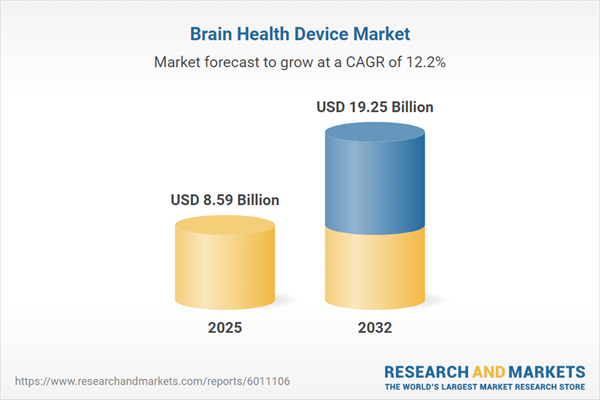Speak directly to the analyst to clarify any post sales queries you may have.
Senior executives navigating the brain health device market face swift changes shaped by continuous innovation, regulatory challenges, and evolving user expectations. Modern strategies centered on digital transformation are increasingly vital for maintaining a sustainable advantage in a highly competitive landscape.
Market Snapshot: Brain Health Device Market Size, Growth, and Trends
The global brain health device market achieved a value of USD 7.67 billion in 2024 and is set to grow to USD 8.59 billion in 2025, reflecting a robust 12.19% compound annual growth rate. Market expansion is propelled by widespread adoption of neurostimulation and digital cognitive assessment tools, coupled with the rise of wearable technologies enabling remote patient monitoring. These advancements are expanding access to therapies and promoting proactive, individualized care. Strong investment in digital strategies is facilitating product innovation, as organizations seek solutions that align with emerging clinical and consumer challenges. Rapid technological evolution is influencing care protocols and enhancing patient engagement across diverse healthcare settings.
Scope & Segmentation: Brain Health Device Market
A thorough understanding of key segments is essential for decision-makers developing targeted investments and market-entry plans. Each segment contributes uniquely to market growth and differentiation, supporting tailored strategies for organizational success.
- Device Types: Including noninvasive nerve stimulators, cognitive assessment tools, neurofeedback systems, and smart wearables, these devices serve clinical diagnostics, ongoing monitoring, and consumer wellness efforts.
- Technologies: Core advancements such as electroencephalography, functional near-infrared spectroscopy, transcranial direct current stimulation, and magnetic stimulation are increasing treatment precision for various neurological conditions.
- Applications: These devices enhance neurology, psychiatric care, and sports performance by supporting early detection and tailored interventions in preventive and therapeutic environments.
- End Users: Specialized care providers, hospitals, research institutes, and households all require solutions that are user-friendly and compliant for high-quality brain health services.
- Distribution Channels: The availability of products through retail outlets and digital channels streamlines organizational procurement and broadens direct consumer access for home-based and point-of-use care.
- Demographic Groups: Products are designed to address ergonomic and compliance needs across adults, seniors, and pediatric users, ensuring broad-based safety and usability.
- Regions: Major innovation hubs such as the United States, China, and Germany influence global trends, while local regulations and economic factors determine technology deployment pace and adoption strategies.
- Leading Companies: Organizations such as Medtronic plc, Abbott Laboratories, Boston Scientific Corporation, and Nevro Corp are investing in partnerships and collaborative R&D to build differentiated portfolios and sustain market relevance.
Key Takeaways for Senior Decision-Makers
- Hybrid neuromodulation platforms are enabling flexible care models, allowing organizations to quickly adapt to varied patient and provider requirements.
- Wearable and remote monitoring devices promote patient engagement and facilitate seamless care transitions from clinical to home-based settings.
- Collaboration among device manufacturers, technology suppliers, and research teams helps streamline development and regulatory processes for faster market entry.
- Distinct commercial and localization approaches help organizations differentiate offerings and foster trust with diverse customer segments.
- Integration with existing healthcare IT infrastructures supports efficient roll-out of new brain health solutions and accelerates broader digital transformation efforts.
- Flexible device platforms empower organizations to anticipate and manage regulatory changes, supporting cost optimization and responsive strategy development.
Tariff Impact on Market Strategy
US tariffs on imported components are driving up manufacturing costs for brain health device producers. To counter these effects, organizations are diversifying suppliers, investing in domestic production, and seeking alternative components. These actions enhance operational resilience and bolster competitive positioning amid shifting regulations.
Methodology & Data Sources
This analysis synthesizes expert insights from neurologists, device manufacturers, and clinicians. Findings are confirmed by peer-reviewed literature, regulatory sources, and healthcare databases. Multiple perspectives ensure accuracy and regional relevance within the brain health device market.
Why This Report Matters
- Presents actionable strategies to drive neurotechnology innovation and progress digital transformation throughout complex healthcare systems.
- Prepares senior decision-makers to address dynamic supply chain and regulatory disruptions unique to the brain health device sector.
- Supports informed choices around resourcing, partnerships, and targeted international expansion for sustainable growth.
Conclusion
By emphasizing strategic flexibility and aligning closely with clinical needs, organizations will achieve sustained growth and effectively navigate the fast-evolving brain health device sector.
Additional Product Information:
- Purchase of this report includes 1 year online access with quarterly updates.
- This report can be updated on request. Please contact our Customer Experience team using the Ask a Question widget on our website.
Table of Contents
3. Executive Summary
4. Market Overview
7. Cumulative Impact of Artificial Intelligence 2025
Companies Mentioned
The companies profiled in this Brain Health Device market report include:- Medtronic plc
- Abbott Laboratories
- Boston Scientific Corporation
- Nevro Corp.
- LivaNova PLC
- NeuroPace, Inc.
- NeuroSigma, Inc.
- Neuroelectrics Barcelona S.L.
- NeuroSky, Inc.
- InteraXon Inc.
Table Information
| Report Attribute | Details |
|---|---|
| No. of Pages | 180 |
| Published | October 2025 |
| Forecast Period | 2025 - 2032 |
| Estimated Market Value ( USD | $ 8.59 Billion |
| Forecasted Market Value ( USD | $ 19.25 Billion |
| Compound Annual Growth Rate | 12.1% |
| Regions Covered | Global |
| No. of Companies Mentioned | 11 |









